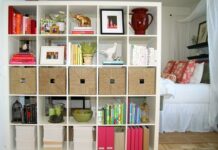By Melissa Rayworth
Warm weather is upon us. Though your garden is filling in, you can also add beauty and fragrance to your home by decorating with lush plants and potted trees.
Decorating with plants “kind of fell out of vogue” for a time, said California-based interior designer Molly Luetkemeyer. “It was such a ’70s thing, or I think people associated it with the ’70s,” but it’s become popular again in recent years.
Today, “designer spaces pretty much always include some element of life,” said interior designer Brian Patrick Flynn, founder of decordemon.com. “While that can be anything from coral to tortoise shells, pressed leaves or even a tiny bowl with a goldfish, the most common way to add life is with potted plants and trees.”
We’ve asked Flynn, Luetkemeyer and Betsy Burnham of Burnham Design in Los Angeles for advice on choosing the right plants, potting them perfectly and keeping them blooming with minimal effort.
“Talking to someone at a nursery is a really good idea,” said Burnham, because employees at garden stores and plant nurseries are usually glad to answer questions about choosing and caring for plants.
You can choose plants based on the spot in your home where you’d like to keep them (sundrenched windowsills, shady corners or in-between spaces that get a mix of sun and shade). Or you can select a plant you love and then ask for advice on where to place it.
If you have pets, ask whether a plant you’re considering is poisonous. And if you want plants that need very little attention, don’t be shy about saying so.
“While I’m a fan of making a big statement with greenery,” Flynn said, “I’m only interested in plants and trees that are low-maintenance. Give me something that requires daily care and/or delicate grooming, and it’s most likely to go from green to brown or black in less than 72 hours.”
All three designers like ferns, such as the maidenhair. “They’re so delicate and soft,” said Luetkemeyer. “They’re fresh, and they’re that pale green that’s the beginning green of spring.”
Maidenhairs are fairly easy to care for: “They need to be watered,” she said, “but if you water them, they hang around.”
Consider grouping several together in small pots or buying just one large fern.
“They can ground a space grouped together in odd numbers in pots of varied heights on the floor,” Flynn said. Or “you can use them to add life high up in a room with hanging basket planters. And then they also look excellent potted and placed on a pedestal, coffee table or console table.”
If you want something larger and bolder than the delicate maidenhair, Flynn suggests the staghorn fern. Just remember that all ferns do best in shade rather than direct sunlight.
“I love plants that flower in the spring,” said Luetkemeyer, who recommends daffodils, narcissus and hyacinth.
She also loves gardenia plants for their heady fragrance and shiny leaves. But they do require a bit of effort.
“Any plant that’s a woody plant, with a wood that’s exposed, is going to be a little bit trickier,” she said. Consider researching gardenias online to learn how much water and how much light your plant will need.
And with all potted plants, Luetkemeyer suggests placing a dish underneath the pot to catch and maintain the water, then placing a coaster underneath the dish to protect the furniture or floor.
“A statement tree,” said Burnham, “adds height to your room, and plays with the light at a window.”
Flynn also suggests fig trees: “Fiddle leaf fig trees are, hands down, my favorite,” he said. “They’re super architectural and almost kind of minimalist. Since these grow straight upwards, they’re perfect for corners or flanking a fireplace or focal point without growing out and over it.”
“I also use fiddle leaf fig trees in unexpected places,” he said, “just to add a big burst of life into an otherwise utilitarian space such as a bathroom or even offices. The key to using them successfully is ensuring they don’t come into contact with direct light, and that they’re not exposed to dry heat.”
“This might be a great time to put some herbs in your kitchen,” Luetkemeyer said.
Many grocery stores and nurseries sell herb plants such as mint or basil that are already blooming in small plastic pots. You can re-pot them into more attractive containers, and then cluster them together on a countertop.
“What you plant something in makes just as much of a statement as the tree or plant itself,” said Burnham.
Take time shopping for exactly what you want. “Add a little extra effort,” she said, “and you get a really chic little addition to your room.”
One simple approach is to “put the plant into a fabulous low basket and cover it with reindeer moss,” Burnham said. “You don’t see the soil, and don’t see the plastic container inside.”
Luetkemeyer agrees that it’s worth taking time to choose the right pots: “You can take the same plant and pot it four different ways and it creates four different vibes,” she said. A pot is “sort of like the frame on the piece of art. It sets the tone.” — AP












